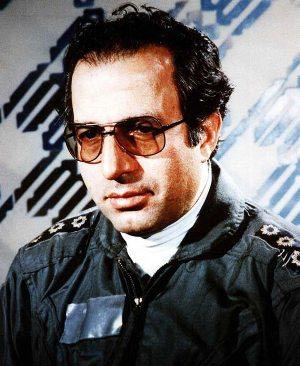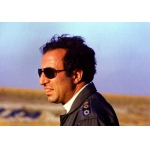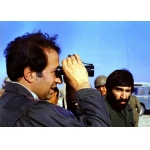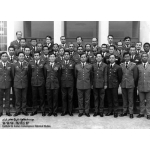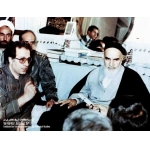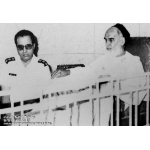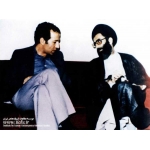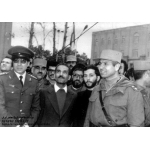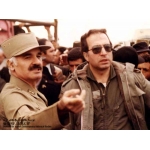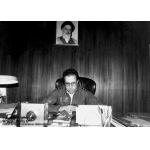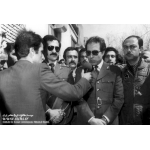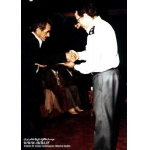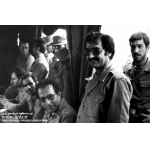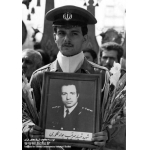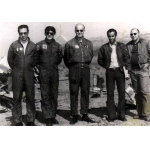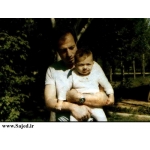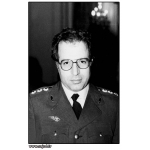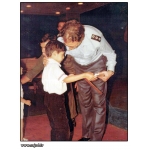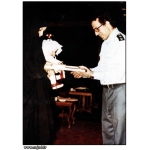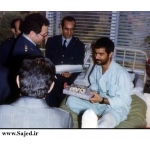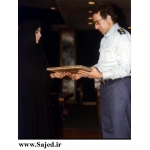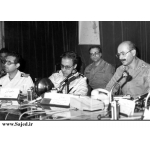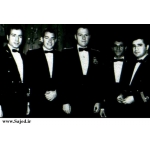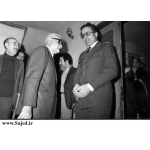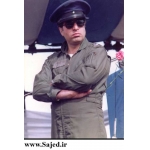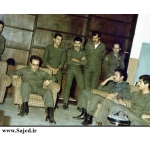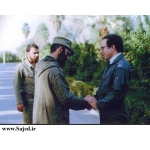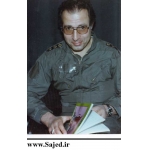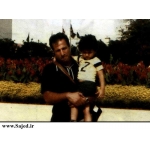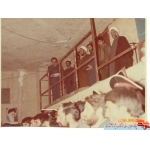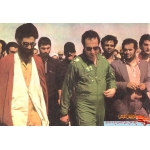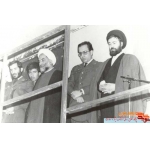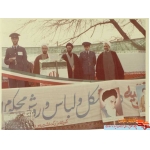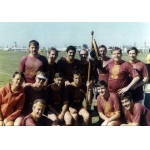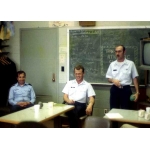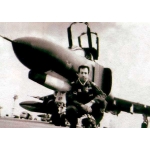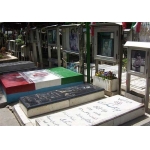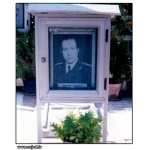Fakoori, Javad
Fatameh Norouzi
525 بازدید
Brigadier General Pilot Javad Fakoori (1938-1981) was the commander of the Islamic Republic of Iran Air Force and served as the Minister of Defense during the early years of the Islamic Revolution. His tenure as the Minister of Defense coincided with the Iran-Iraq War. Tragically, in 1981, he martyred in an aircraft accident.
Javad Fakoori was born in 1938, in Charnadap, a neighborhood in Tabirz. His father relocated the family to Tehran where Fakoori attended Eghbal Elementary School. He would go on to attend Marvi High School where he obtained his diploma in 1958. In 1959, despite being accepted to medical school, he chose to pursue his passion for aviation and in October of that same year, he joined the Air Force Pilot School. In June of 1960, he conducted his first solo flight in a T-33 aircraft over the skies of Doshan Tapeh in Tehran.[1]
Fakoori further honed his skills as he completed an advanced pilot training course in the United States. After a year and a half, having accumulated two hundred and sixty-three hours of flight, he obtained a license to pilot the F-4 Phantom II fighter-bomber. Upon returning to Iran, he served as a second lieutenant at the 1st Fighter Base in Mehrabad, Tehran. He later transferred to the Shiraz Air Base. On February 28, 1965,[2] Fakoori tied the knot. He would go on to have two sons and one daughter.[3]
Prior to the victory of the Islamic Revolution, Fakoori served in key positions, including commanding the 102nd Fighter Squadron, serving in the Standards Branch of the 1st Fighter Squadron, and participating in various operations in coordination with the 3rd Fighter Wing as well as the Stealth Unit.[4] In 1977, Fakoori returned to the United States to undergo training in command. He returned to Iran in March of 1979.
His impressive flight record included 3340 hours of flight on the F-4. In addition, he excelled in various training programs and was proficient in flying various fighter and bomber aircraft. He was widely regarded as one of the elite pilots in the world.[5] In August of 1979, he was appointed as the commander of the 2nd Fighter Air Base in Tabriz.[6]
From late 1978, Tabriz was embroiled in the turmoil caused by the separatist Tudeh Party. During this period, some members of the 2nd Fighter Air Base, who were supporters of this party requested weapons and ammunition from Fakoori. However, when he refused their request, he was taken hostage. After 48 hours, he was rescued and freed by Mostafa Ardastani, a fellow pilot, and other members of the Air Force.[7] In dealing with these insurgents, Fakoori successfully restored calm and order to the base and the city of Tabriz. Shortly after, he transferred to Tehran where he took over as commander of the 1st Fighter Air Base. As commander of the Air Base, Fakoori and his comrades played an instrumental role in neutralizing the activities and conspiracies of the leftist and the Munafiqeen.[8] In late 1979, Fakoori was appointed as the Deputy Chief of Operation for the Air Force, and on May 27, 1980, Imam Khomeini had issued the order for him to become the commander of the Air Force.
As the NEQAB (Nojeh) Coup began on July 8, 1980, Fakoori played a pivotal role in thwarting it.[9] In a letter he had addressed to Imam Khomeini, Fakoori sought instruction on how to deal with the perpetrators of the failed coup and advice on how to deal with the problems caused by the coup. In his response, Imam wrote, “The families of the Nojeh Coup plotters should be able to live peacefully within the confines of the Islamic nation.”[10]
On September 11, 1980, Fakoori was elected to be the Prime Minister of Muhammad Ali Rajai’s government, an office he held concurrently with being the Minister of Defense. At the very onset of the Iran-Iraq War on September 22, 1980, Javad Fakoori declared a state of emergency and ordered all base commanders to be fully prepared for a confrontation against the enemy. In addition, he issued a mission for the 1st Fighter Air Base to engage in retaliatory strikes against Iraq. On the same day as the mission was issued, Iranian pilots successfully bombed the Kut and Shaibah Bases on the outskirts of Basra,
Fakoori was also responsible for planning and executing Operation Kaman 99, also known as Operation Alborz. In the early hours of October 23, 1980, Iranian fighter jets simultaneously attacked every Iraqi air base, except for Al-Waleed. Because this operation involved using one hundred and forty sorties, it came to famously being referred to as ‘Operation 140 Sorties’.[11]
Two weeks after the start of the war, Fakoori received intelligence about advanced aircrafts and bombers that were stationed at the Al-Waleed Air Base. Subsequent to meetings with senior Air Force commanders and intelligence officers, an operational plan to strike this air base was approved. The operation was successfully carried out on April 4, 1981.[12] In September of 1981, Operation Thamin al-A’imma was conceived. Fakoori played an instrumental and influential role in designing this operation and leading its forces. After the success and victory of this operation, on the 29th of September, Fakoori visited Iraqi prisoners of war held at the 77th Khorasan Division Headquarters in Mahshahr. He was accompanied by Valiollah Fallahi, the Minister of Defense, and Colonel Seyyed Mousa Namjoo. That evening Fakoori accompanied by other Army and IRGC commanders, boarded a C-130 aircraft. They were on their way back to Tehran to report on the operation’s success. Tragically, the aircraft crashed and caught on fire in the southwest of Kharizak. This tragic event led to the martyrdom of Brigadier General Javad Fakoori, Colonel Mousa Namjoo, General Valiollah Fallahi, Yousseff Kalahdouz, and Mohammad Jahanara.[13] Imam Khomeini issued a statement of condolence the following day,[14] and the Provisional Presidential Council declared three days of national mourning.[15] The body of Martyr Brigadier General Javad Fakoori, along with the other martyrs, was laid to rest on the 1st of October, 1981 in front of the Officer Training College in Tehran.[16] He was buried in Section 24, Row 73, Grave 25 of Behesht Zahra Cemetery.[17]
[1] Qazi Mirsaeed, Seyyed Hekmat, Chashmi Dar Aseman (An Eye in the Sky), Tehran: Political Ideological Organization of the Army of the Islamic Republic of Iran, 2004, p. 17.
[2] Shahed Yaran, No. 124, February 2015, p. 6.
[3] Mushtaq, Zahra, Fakuri narrated by the martyr's wife, Tehran: Revayat Fath, 2003, pp. 9, 32, 37, and 43.
[4] Qazi Mirsaeed, Seyyed Hekmat, Chashmi Dar Aseman (An Eye in the Sky), p.18.
[5] Shahed Yaran, No. 124, p. 7.
[6] Mehrnia, Ahmad, Setareh hay Nabard Havaee Stars of Air Battle, Vol. 3, Tehran: Soure Mehr, 2016, p. 452.
[7] Shahed Yaran, No. 124, pp. 8 and 9.
[8] Ibid; pp. 8 and 9.
[9] Shahed Yaran, No. 124, p. 9.
[10] Ibid; p. 10.
[11] Qazi Mirsaeed, Seyyed Hekmat, Chashmi Dar Aseman (An Eye in the Sky), pp. 137-140, Shahed Yaran, No. 124, pp. 10 and 11.
[12] Shahed Yaran, No. 124, pp. 11 and 12.
[13] Ibid; p. 12.
[14] Qazi Mirsaeed, Seyyed Hekmat, Chashmi Dar Aseman (An Eye in the Sky), p. 171.
[15] Keyhan Newspaper, No. 11397, October 1, 1981, p. 2.
[16] Jomhoori Eslami Newspaper, No. 675, October 3, 1981, p. 10.
[17] http://mazareshahid.ir/11363


